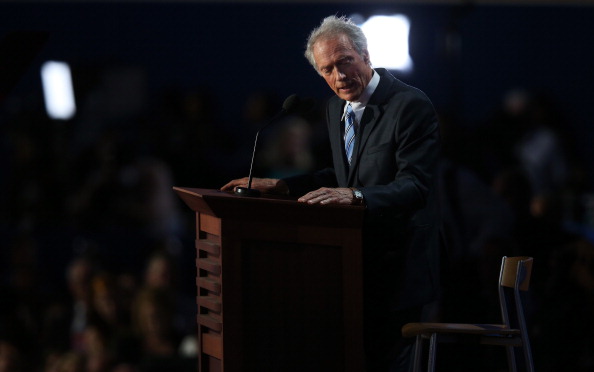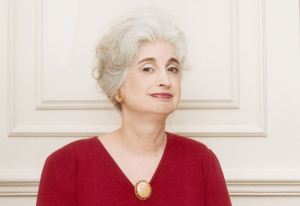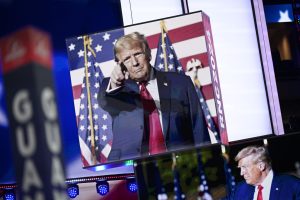By Will Weissert, Associated Press
WASHINGTON (AP) — In 1948, the Republican and Democratic parties did something unthinkable in today’s climate of ferocious political animosity: They not only held their national conventions in the same city, but shared some of the props.
Both gathered in Philadelphia, largely because its Municipal Auditorium had already been fitted with the wiring needed for then-groundbreaking live convention coverage on national television.
Related Articles
The RNC’s first day will still focus on the economy. Here’s what to know about Trump’s plans
When does a presumptive nominee become a nominee? Here’s how Donald Trump will make it official
America’s toxic political climate faces calls to ‘tone it down’ after assassination attempt on Trump
Trump shooting changes Biden’s strategy to revive 2024 campaign
A timeline of the assassination attempt on former President Trump
To save money, Democrats asked Republicans to leave the American flags and bunting up to be reused at its event 17 days later. The GOP complied, though some items became faded and worn in the interval.
Like party comradery, the more informal way conventions were staged has evaporated. Once bare-knuckled showdowns to hammer out presidential nominees, modern gatherings have evolved into carefully scripted, made-for-TV events meant to showcase party unity.
Republicans are largely on track to deliver that as they nominate former President Donald Trump in Milwaukee this week. The Democratic convention could feature more drama when it opens on Aug. 19, given the bitter debate over whether President Joe Biden should stay atop the party’s ticket.
But even with conventions now choreographed down to tiny details, the unexpected can still happen. Here’s a look at the floor fights, street battles, and other memorable convention scenes that were uplifting, outlandish or just plain awkward:
Ted Cruz’s non-endorsement
As the last candidate Donald Trump defeated during the 2016 GOP primary, Texas Sen. Ted Cruz amassed enough delegates to address the party’s convention in Cleveland — but balked at endorsing his former rival.
Still smarting over Trump calling him “Lyin’ Ted,” mocking his wife Heidi Cruz’s appearance and suggesting that the senator’s Cuba-born father was involved in the assassination of John F. Kennedy, Cruz implored delegates to “vote your conscience.” It drew prolonged boos.
Cruz reversed himself and endorsed Trump that fall, and today is among his staunchest defenders. But, at the time, the vitriol was high enough that Heidi Cruz was led from the convention floor, just in case.
Clint Eastwood’s empty chair
A head-scratching moment came in 2012, when Clint Eastwood addressed the Republican gathering in Tampa, Florida, with an empty chair standing in for then-President Barack Obama.
Actor Clint Eastwood speaks during the final day of the Republican National Convention at the Tampa Bay Times Forum on August 30, 2012 in Tampa, Florida. (Mark Wilson/Getty Images)
The actor and director spent 12 minutes conversing with the piece of furniture, and even dodging barrages of imaginary obscenities from it.
“What do you mean shut up?” Eastwood crowed.
He also joked about then-Vice President Biden’s reputation for gaffes — launching criticisms that may prove prescient given current questions about whether Biden can handle a second term, following his disastrous debate performance.
“Of course, we all know Biden is the intellect of the Democratic party,” Eastwood told the chair. “Just kind of a grin, with a body behind it.”
‘Audacity of hope’
The year 2004 was otherwise terrible for Democrats, President George W. Bush won reelection and Republicans retained control of Congress. But one bright spot came from Obama, then a little-known Illinois state senator, electrifying his party’s Boston convention.
Obama dubbed himself “a skinny kid with a funny name who believes that America has a place for him, too” and summed up his political philosophy as being built around “the audacity of hope.”
Gore’s extra-long kiss
As he stepped on stage to deliver a speech accepting his party’s 2000 presidential nomination in Los Angeles, Al Gore embraced his wife Tipper and gave her a full-mouthed kiss, hanging on much longer than usual for a display of passion in public.
Democratic presidential candidate Al Gore kisses his wife Tipper after she introduced him to the Democratic National Convention at the Staples Center, August 17, 2000 in Los Angeles, California. (LUCY NICHOLSON/AFP via Getty Images)
The crow cheered, but the kiss eventually encompassed an uncomfortable three seconds of screen time.
Gore had been battling criticisms that he was too stiff during public appearances, which may have explained how hard he leaned in. Regardless, the smooch was remembered more than Gore’s speech.
He went on to narrowly lose that November to Bush. A decade later, the Gores separated after 40 years of marriage.
Women on the ticket
At the Democrats’ 1984 convention in San Francisco, presidential nominee Walter Mondale announced Geraldine Ferraro as his running mate, making her the first woman on a major presidential ticket. Ferraro declared, “America is the land where dreams can come true for all of us,” though she and Mondale went on to win just 13 electoral votes compared to President Ronald Reagan ‘s 525.
Twenty years later, Sen. John McCain chose Sarah Palin as his vice presidential candidate, and her speech at the Republican convention in St. Paul, Minnesota, was a hit, mixing the then-Alaska governor’s compelling personal story with humor and political punch. It gave McCain a boost, but he still lost to Obama.
At the 2016 Democratic convention in Philadelphia, Hillary Clinton became the first major party female presidential nominee, declaring, “When any barrier falls in America, for anyone, it clears the way for everyone.” She eventually lost to Trump.
Kamala Harris was the first woman on a winning ticket, accepting being Biden’s running mate during a mostly virtual convention last cycle — and now is some Democrats’ choice to replace Biden in this year’s presidential race.
Opposing the incumbent
In 1976, Reagan, then California’s governor, challenged President Gerald Ford from the right and touched off a bitter struggle at the GOP’s convention in Kansas City. Ford narrowly prevailed with 1,187 votes to 1,070, but lost that November to Democrat Jimmy Carter.
Four years later, at the Democratic convention in New York, Carter himself faced a floor challenge from Massachusetts Sen. Ted Kennedy, who badly trailed the president in delegates but tried to loosen rules on how they were pledged to vote. Tensions ran high and, though the change was defeated, Carter later lost to Reagan.
Eagleton’s 18-day vice presidential candidacy
Biden facing increasing pressure to leave the race is without modern precedent at the top of a presidential ticket — but not when it comes to a nominee’s running mate.
Shortly after the 1972 Democratic convention in Miami, reports surfaced that Democratic presidential nominee George McGovern ’s vice presidential pick, Missouri Sen. Thomas Eagleton, had previously undergone electroshock therapy to treat depression.
A divided convention had prompted McGovern to tap Eagleton on its final day, after he was turned down by several alternatives. Eagleton therefore didn’t receive much vetting of his record, which might have surfaced the medical disclosures earlier.
Eagleton resigned after 18 days on the ticket and was replaced by Sargent Shriver. Incumbent Republican President Richard Nixon went on to win 49 out of 50 states that November.
Chaos in Chicago
After President Lyndon B. Johnson opted not to seek reelection and Robert F. Kennedy was assassinated, Vice President Hubert Humphrey secured the 1968 Democratic nomination at the party’s convention. But that was only after a raucous floor fight which ended with delegates defeating a peace platform seeking an end to the Vietnam war.
A police officer escorts a protestor to a squad car surrounded by dozens of anti-Vietnam War demonstrators outside the 1968 Democratic National Convention, Chicago, Illinois, August 1968. (Photo by Hulton Archive/Getty Images)
What happened at the convention was overshadowed by thousands of anti-war protesters who marched in the streets. Demonstrators were attacked by police, sparking such turmoil that the tear gas fired reached the 25th floor hotel suite where Humphrey was preparing for his appearance at a hotel five miles from the convention site.
The Democratic convention returns to Chicago in a few weeks, and widespread demonstrations are being planned to oppose the Biden administration’s support for Israel in its war with Hamas — leaving some to wonder whether a 1968 redux could be coming. With questions about Biden staying in the race still being raised, things inside the convention might get equally heated.












